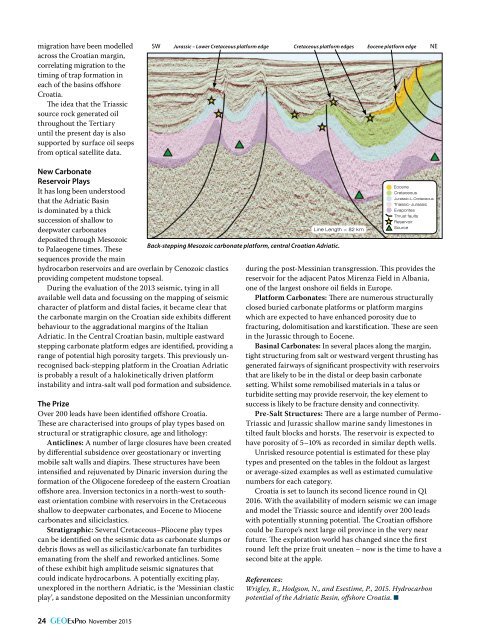Iraqi Kurdistan All in the Timing
GEO_ExPro_v12i6
GEO_ExPro_v12i6
Create successful ePaper yourself
Turn your PDF publications into a flip-book with our unique Google optimized e-Paper software.
migration have been modelled<br />
across <strong>the</strong> Croatian marg<strong>in</strong>,<br />
correlat<strong>in</strong>g migration to <strong>the</strong><br />
tim<strong>in</strong>g of trap formation <strong>in</strong><br />
each of <strong>the</strong> bas<strong>in</strong>s offshore<br />
Croatia.<br />
The idea that <strong>the</strong> Triassic<br />
source rock generated oil<br />
throughout <strong>the</strong> Tertiary<br />
until <strong>the</strong> present day is also<br />
supported by surface oil seeps<br />
from optical satellite data.<br />
SW<br />
Jurassic – Lower Cretaceous platform edge Cretaceous platform edges Eocene platform edge<br />
NE<br />
New Carbonate<br />
Reservoir Plays<br />
It has long been understood<br />
that <strong>the</strong> Adriatic Bas<strong>in</strong><br />
is dom<strong>in</strong>ated by a thick<br />
succession of shallow to<br />
deepwater carbonates<br />
deposited through Mesozoic<br />
to Palaeogene times. These<br />
sequences provide <strong>the</strong> ma<strong>in</strong><br />
hydrocarbon reservoirs and are overla<strong>in</strong> by Cenozoic clastics<br />
provid<strong>in</strong>g competent mudstone topseal.<br />
Dur<strong>in</strong>g <strong>the</strong> evaluation of <strong>the</strong> 2013 seismic, ty<strong>in</strong>g <strong>in</strong> all<br />
available well data and focuss<strong>in</strong>g on <strong>the</strong> mapp<strong>in</strong>g of seismic<br />
character of platform and distal facies, it became clear that<br />
<strong>the</strong> carbonate marg<strong>in</strong> on <strong>the</strong> Croatian side exhibits different<br />
behaviour to <strong>the</strong> aggradational marg<strong>in</strong>s of <strong>the</strong> Italian<br />
Adriatic. In <strong>the</strong> Central Croatian bas<strong>in</strong>, multiple eastward<br />
stepp<strong>in</strong>g carbonate platform edges are identified, provid<strong>in</strong>g a<br />
range of potential high porosity targets. This previously unrecognised<br />
back-stepp<strong>in</strong>g platform <strong>in</strong> <strong>the</strong> Croatian Adriatic<br />
is probably a result of a halok<strong>in</strong>etically driven platform<br />
<strong>in</strong>stability and <strong>in</strong>tra-salt wall pod formation and subsidence.<br />
The Prize<br />
Over 200 leads have been identified offshore Croatia.<br />
These are characterised <strong>in</strong>to groups of play types based on<br />
structural or stratigraphic closure, age and lithology:<br />
Anticl<strong>in</strong>es: A number of large closures have been created<br />
by differential subsidence over geostationary or <strong>in</strong>vert<strong>in</strong>g<br />
mobile salt walls and diapirs. These structures have been<br />
<strong>in</strong>tensified and rejuvenated by D<strong>in</strong>aric <strong>in</strong>version dur<strong>in</strong>g <strong>the</strong><br />
formation of <strong>the</strong> Oligocene foredeep of <strong>the</strong> eastern Croatian<br />
offshore area. Inversion tectonics <strong>in</strong> a north-west to sou<strong>the</strong>ast<br />
orientation comb<strong>in</strong>e with reservoirs <strong>in</strong> <strong>the</strong> Cretaceous<br />
shallow to deepwater carbonates, and Eocene to Miocene<br />
carbonates and siliciclastics.<br />
Stratigraphic: Several Cretaceous–Pliocene play types<br />
can be identified on <strong>the</strong> seismic data as carbonate slumps or<br />
debris flows as well as silicilastic/carbonate fan turbidites<br />
emanat<strong>in</strong>g from <strong>the</strong> shelf and reworked anticl<strong>in</strong>es. Some<br />
of <strong>the</strong>se exhibit high amplitude seismic signatures that<br />
could <strong>in</strong>dicate hydrocarbons. A potentially excit<strong>in</strong>g play,<br />
unexplored <strong>in</strong> <strong>the</strong> nor<strong>the</strong>rn Adriatic, is <strong>the</strong> ‘Mess<strong>in</strong>ian clastic<br />
play’, a sandstone deposited on <strong>the</strong> Mess<strong>in</strong>ian unconformity<br />
L<strong>in</strong>e Length = 82 km<br />
Back-stepp<strong>in</strong>g Mesozoic carbonate platform, central Croatian Adriatic.<br />
Eocene<br />
Cretaceous<br />
Jurassic-L.Cretaceous<br />
Triassic-Jurassic<br />
Evaporites<br />
Thrust faults<br />
Reservoir<br />
Source<br />
dur<strong>in</strong>g <strong>the</strong> post-Mess<strong>in</strong>ian transgression. This provides <strong>the</strong><br />
reservoir for <strong>the</strong> adjacent Patos Mirenza Field <strong>in</strong> Albania,<br />
one of <strong>the</strong> largest onshore oil fields <strong>in</strong> Europe.<br />
Platform Carbonates: There are numerous structurally<br />
closed buried carbonate platforms or platform marg<strong>in</strong>s<br />
which are expected to have enhanced porosity due to<br />
fractur<strong>in</strong>g, dolomitisation and karstification. These are seen<br />
<strong>in</strong> <strong>the</strong> Jurassic through to Eocene.<br />
Bas<strong>in</strong>al Carbonates: In several places along <strong>the</strong> marg<strong>in</strong>,<br />
tight structur<strong>in</strong>g from salt or westward vergent thrust<strong>in</strong>g has<br />
generated fairways of significant prospectivity with reservoirs<br />
that are likely to be <strong>in</strong> <strong>the</strong> distal or deep bas<strong>in</strong> carbonate<br />
sett<strong>in</strong>g. Whilst some remobilised materials <strong>in</strong> a talus or<br />
turbidite sett<strong>in</strong>g may provide reservoir, <strong>the</strong> key element to<br />
success is likely to be fracture density and connectivity.<br />
Pre-Salt Structures: There are a large number of Permo-<br />
Triassic and Jurassic shallow mar<strong>in</strong>e sandy limestones <strong>in</strong><br />
tilted fault blocks and horsts. The reservoir is expected to<br />
have porosity of 5–10% as recorded <strong>in</strong> similar depth wells.<br />
Unrisked resource potential is estimated for <strong>the</strong>se play<br />
types and presented on <strong>the</strong> tables <strong>in</strong> <strong>the</strong> foldout as largest<br />
or average-sized examples as well as estimated cumulative<br />
numbers for each category.<br />
Croatia is set to launch its second licence round <strong>in</strong> Q1<br />
2016. With <strong>the</strong> availability of modern seismic we can image<br />
and model <strong>the</strong> Triassic source and identify over 200 leads<br />
with potentially stunn<strong>in</strong>g potential. The Croatian offshore<br />
could be Europe’s next large oil prov<strong>in</strong>ce <strong>in</strong> <strong>the</strong> very near<br />
future. The exploration world has changed s<strong>in</strong>ce <strong>the</strong> first<br />
round left <strong>the</strong> prize fruit uneaten – now is <strong>the</strong> time to have a<br />
second bite at <strong>the</strong> apple.<br />
References:<br />
Wrigley, R., Hodgson, N., and Esestime, P., 2015. Hydrocarbon<br />
potential of <strong>the</strong> Adriatic Bas<strong>in</strong>, offshore Croatia.<br />
24 GEOExPro November 2015


